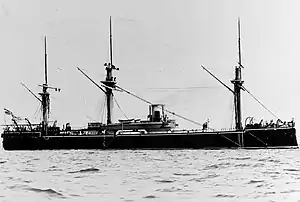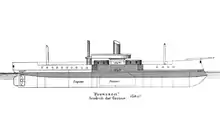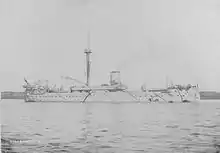SMS Preussen (1873)
SMS Preussen [lower-alpha 1] was an ironclad turret ship built for the German Kaiserliche Marine (Imperial Navy). The ship was built by the AG Vulcan shipyard in Stettin in 1871–1876; she was commissioned into the fleet in July 1876. She was the first large warship of the German navy built by a private shipyard; all previous vessels had been ordered abroad or built by Royal or Imperial dockyards. Her main battery of four 26 cm (10.2 in) guns was mounted in a pair of twin gun turrets amidships.
- For the battleship of the same name, see SMS Preussen
 Preussen in 1887 | |
| History | |
|---|---|
| Name: | SMS Preussen |
| Namesake: | Prussia |
| Builder: | AG Vulcan, Stettin |
| Laid down: | 1871 |
| Launched: | 22 November 1873 |
| Commissioned: | 4 July 1876 |
| Decommissioned: | 1906 |
| Fate: | Scrapped 1919 |
| General characteristics | |
| Class and type: | Preussen-class ironclad |
| Displacement: | |
| Length: | 96.59 m (316 ft 11 in) |
| Beam: | 16.30 m (53 ft 6 in) |
| Draft: | 7.11 m (23 ft 4 in) |
| Installed power: | |
| Propulsion: | |
| Sail plan: | Full-rigged ship |
| Speed: | 14 knots (26 km/h; 16 mph) |
| Range: | 1,690 nmi (3,130 km) at 10 kn (19 km/h) |
| Complement: |
|
| Armament: |
|
| Armor: | |
Preussen served with the fleet from her commissioning until 1891, though she was frequently placed in reserve throughout her career. She cruised the Mediterranean Sea several times during her service, including during a mission in 1877 after unrest in the Ottoman Empire threatened German citizens living there. The ship was withdrawn from service at the end of 1891 and used as a harbor guard ship until 1896, when she was relegated to being a supply ship in Wilhelmshaven. She ended her career as a coal hulk for torpedo boats. In 1903, she was renamed Saturn so her name could be reused. The ship was ultimately sold to shipbreakers in 1919.
Design

The three Preussen-class ironclads were authorized under the naval program of 1867, which had been approved by the Reichstag (Imperial Diet) to strengthen the North German Federal Navy in the wake of the Second Schleswig War, when the weak, then-Prussian Navy had been unable to break the blockade imposed by the Danish Navy. Initially ordered as casemate ships, the vessels were re-designed as turret ships; they were the first uniform class of ironclads built by for the German fleet.[1]
The ship was 96.59 meters (316.9 ft) long overall and had a beam of 16.30 m (53.5 ft) and a draft of 7.12 m (23.4 ft) forward.[2] Preussen was powered by one 3-cylinder single-expansion steam engine, which drove a single screw propeller. Steam was supplied by six coal-fired transverse trunk boilers, which were vented into a single funnel. The ship's top speed was 14 knots (26 km/h; 16 mph), at 5,471 metric horsepower (5,396 ihp). She was also equipped with a full ship rig. Her standard complement consisted of 46 officers and 454 enlisted men.[3]
She was armed with a main battery of four 26 cm (10.2 in) L/22 guns mounted in a pair of gun turrets placed on the centerline amidships.[lower-alpha 2] As built, the ship was also equipped with two 17 cm (6.7 in) L/25 chase guns, one in the bow and one in the stern.[4] After being rebuilt in 1888–1890, her armament was increased by six and later ten 8.8 cm (3.5 in) L/30 quick-firing guns, a pair of machine guns, and five 35 cm (14 in) torpedo tubes, all submerged in the ship's hull.[3]
Preussen's armor was made of wrought iron and backed with teak. The armored belt was arrayed in two strakes. The upper strake was 203 mm (8 in) thick; the lower strake ranged in thickness from 102 to 229 mm (4 to 9 in). Both were backed with 234 to 260 mm (9.2 to 10.2 in) of teak. The gun turrets were protected by 203 to 254 mm (8 to 10 in) armor on the sides, backed by 260 mm of teak.[2]
Service history
Construction – 1883
Preussen was ordered by the Imperial Navy from the AG Vulcan shipyard in Stettin; her keel was laid in 1871 under construction number 66.[2] This was the first time a private German shipbuilder was given a contract to build a large warship for the navy.[5] The ship was launched on 22 November 1873 and commissioned into the German fleet on 4 July 1876.[4] Although she was the third and final ship in her class to be laid down, she was the first to be launched and commissioned. This was because her two sisters, Friedrich der Grosse and Grosser Kurfürst, were built by newly established Imperial dockyards, while Preussen was built by an experienced commercial ship builder.[6]
After her commissioning in July 1876, Preussen served with the fleet.[4] She joined a squadron sent to the Mediterranean Sea in 1877 in response to unrest in the Ottoman Empire related to the Russo-Turkish War; the violence threatened German citizens living there. The squadron, which also included the two Kaiser-class ironclads, the armored frigate Friedrich Carl, and the aviso Falke, was commanded by Konteradmiral (Rear Admiral) Carl Ferdinand Batsch. The ships steamed to the ports of Haifa and Jaffa in July 1877, but found no significant tensions ashore. Batsch then departed and cruised the Mediterranean for the remainder of the summer, returning to Germany in October.[7][8]
_b_752.jpg.webp)
In April 1878, Preussen participated in the fleet maneuvers, again under Batsch's command. By this time, she was joined by her two sister ships, Friedrich der Grosse and Grosser Kurfürst. While steaming in the English Channel on 31 May, the armored frigate König Wilhelm accidentally rammed Grosser Kurfürst; the latter quickly sank with the loss of 276 men.[9] After assisting in the rescue attempt, Preussen escorted the damaged König Wilhelm to Portsmouth, where the Royal Navy made available a dry dock for emergency repairs. Albrecht von Stosch, the chief of the Kaiserliche Marine, ordered Batsch and his staff to return to Germany immediately aboard Preussen and the dispatch vessel Falke.[10] The annual summer maneuvers for 1878 were canceled within a week of the sinking.[11]
In May 1879, the armored squadron was reactivated, composed of Preussen, her sister Friedrich der Grosse, and the old armored frigates Kronprinz and Friedrich Carl. The annual summer training cruise was primarily conducted in just the Baltic Sea, apart from a short voyage in June to the coast of Norway. The four ships returned to Kiel in September, where they were demobilized for the winter. The new armored corvette Sachsen replaced Kronprinz in the squadron in 1880. Wilhelm von Wickede, a former Austrian naval officer, replaced Batsch as the squadron commander. Again, the squadron remained in the Baltic for the summer cruise, with the exception of a short visit to Wilhelmshaven and Cuxhaven in August.[11][12]
The summer cruise in 1881 followed the same pattern as the year previous, though Kronprinz returned in place of Sachsen, which was plagued with engine problems.[13] Wickede again served as the commander. In July, the ships hosted a visit by the British reserve squadron, which by this time included the first British ironclad, HMS Warrior. Preussen and the rest of the squadron visited Danzig in September during a meeting between Kaiser Wilhelm I and the Russian Tsar Alexander III. The 1882 summer cruise included the same four ironclads from the previous year, and was again commanded by Wickede, who had by then been promoted to Konteradmiral. Preussen was kept in reserve during the annual summer maneuvers starting in 1883, as new ships, including the rest of the Sachsen-class ironclads entered service.[14][15] From 1883 to 1885, the ship underwent a modernization that included new boilers and a reconstructed poop deck. Two 37 mm (1.5 in) Hotchkiss guns and five submerged torpedo tubes were added in the hull.[16]
1889–1919

In August 1889, Preussen was reactivated to participate in Kaiser Wilhelm II's visit to Great Britain. The ship was assigned to II Division, along with her sister Friedrich der Grosse and the central battery ironclads Kaiser and Deutschland, under command of Konteradmiral Friedrich Hollmann. The fleet then conducted maneuvers in the North Sea before returning to Germany. Preussen and the rest of II Division became the training squadron for the fleet in 1889–1890, the first year the Kaiserliche Marine maintained a year-round ironclad force. The squadron escorted Wilhelm II's imperial yacht to the Mediterranean; the voyage included state visits to Italy and the Ottoman Empire. The squadron remained in the Mediterranean until April 1890, when it returned to Germany.[17]
Preussen participated in the ceremonial transfer of the island of Helgoland from British to German control in the summer of 1890. She was present during the fleet maneuvers in September, where the entire eight-ship armored squadron simulated a Russian fleet blockading Kiel. II Division, including Preuseen, served as the training squadron in the winter of 1890–1891. The squadron again cruised the Mediterranean, under the command of Konteradmiral Wilhelm Schröder.[18] Preussen saw one final round of fleet maneuvers with II Division in 1891.[19] She was removed from fleet duty to serve as a harbor guard ship at the end of 1891.[4][19]
She was based in Wilhelmshaven as a harbor ship starting on 16 November 1896. She was renamed Saturn on 12 November 1903,[4] so her name could be reused on the new battleship Preussen.[6] The ship was formally stricken from the naval register on 21 May 1906. She was subsequently used as a coal hulk for torpedo boats. After being converted for this use, Saturn could hold up to 5,000 t (4,900 long tons; 5,500 short tons) of coal. She was eventually sold for scrapping on 27 June 1919 and broken up that year in Wilhelmshaven. Her figurehead is on display in the Militärhistorisches Museum der Bundeswehr in Dresden, while her bow ornament is located in the Deutsches Museum in Munich.[4]
Footnotes
Notes
- "SMS" stands for "Seiner Majestät Schiff", or "His Majesty's Ship".
- "L/22" denotes the length of the gun in terms of caliber. A 22 caliber gun is 22 times as long as it is wide in diameter, so a 26 cm L/22 gun is 572 cm (225 in) long.
Citations
- Dodson, pp. 14, 20.
- Gröner, p. 5.
- Gröner, pp. 5–6.
- Gröner, p. 6.
- Sondhaus, p. 109.
- Gardiner, p. 244.
- Sondhaus, p. 122.
- Dodson, p. 25.
- Sondhaus, p. 124.
- Sondhaus, p. 126.
- Sondhaus, p. 140.
- Dodson, p. 26–27.
- Sondhaus, pp. 140–141.
- Sondhaus, pp. 141–142, 161–163.
- Dodson, p. 27.
- Dodson, p. 32.
- Sondhaus, p. 179.
- Sondhaus, p. 192.
- Sondhaus, p. 194.
References
- Dodson, Aidan (2016). The Kaiser's Battlefleet: German Capital Ships 1871–1918. Barnsley: Seaforth Publishing. ISBN 978-1-84832-229-5.
- Gardiner, Robert, ed. (1979). Conway's All the World's Fighting Ships 1860–1905. Greenwich: Conway Maritime Press. ISBN 978-0-8317-0302-8.
- Gröner, Erich (1990). German Warships: 1815–1945. Vol. I: Major Surface Vessels. Annapolis: Naval Institute Press. ISBN 978-0-87021-790-6.
- Sondhaus, Lawrence (1997). Preparing for Weltpolitik: German Sea Power Before the Tirpitz Era. Annapolis: Naval Institute Press. ISBN 978-1-55750-745-7.
